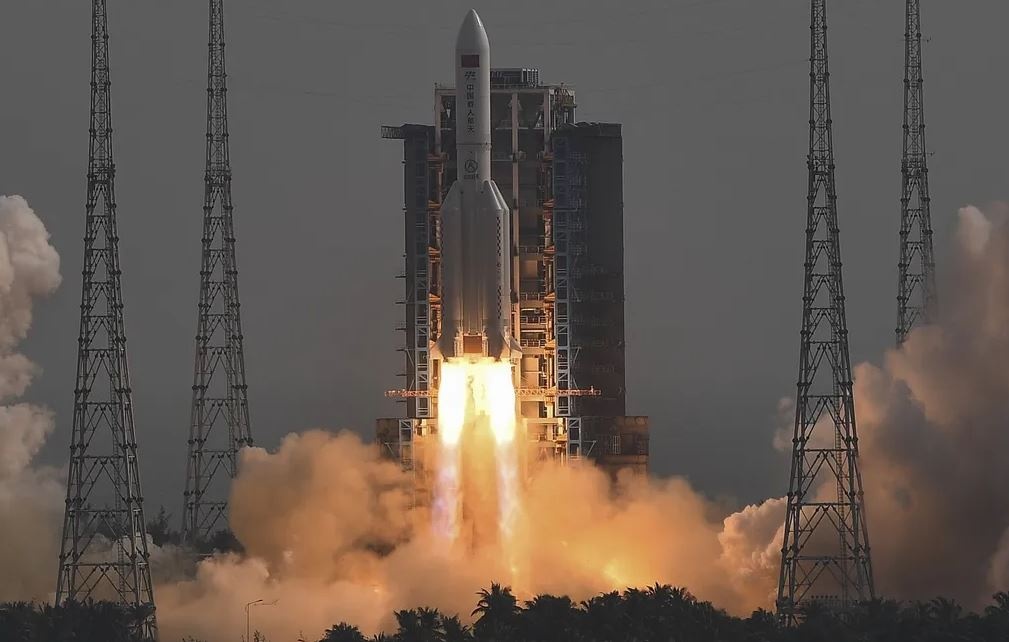Pieces of a 23-ton Chinese rocket stage fell to Earth in the Pacific Ocean on Friday morning, according to two tweets from the United States Space Command.
It was China’s most recent game of cosmic roulette, which included an intentional uncontrolled atmospheric re-entry. By design, the rocket stage lacked a method to steer it to a specified location distant from humans on Earth.
This resulted in anxious sky-watching around the globe. China launched a Long March 5B rocket, one of the most powerful rockets currently in service, on Monday to deliver the third and final module of its Tiangong space station, the centrepiece of its second-most technologically advanced space programme behind NASA.
Each time, China’s wager that the rocket’s components would not harm humans on the ground was successful. Despite the fact that there were no early indications of damage, Friday’s re-entry caused havoc, including the closing of Spanish airspace, which delayed hundreds of morning flights. In 2023, a rocket of the same type is anticipated to be deployed at least once more.
The four rocket launches have been criticised by other space organisations and academics. NASA administrator Bill Nelson made a statement in which he criticised the Chinese for not taking more safeguards, as he did for previous missions in April 2021 and July of this year.
The Long March 5B booster is neither the first or even the biggest man-made item to ever fall from space. And bits of spacecraft from other nations, including the United States, have lately returned to Earth, including a little piece of a SpaceX ship that was discovered in August on an Australian sheep farm.
However, analysts stress that these instances are distinct from China’s deployment of the Long March 5B rocket.
Ted Muelhaupt, a consultant for the Aerospace Corporation, a nonprofit organisation primarily funded by the U.S. government that conducts research and analysis, stated at a news conference on Wednesday, “We, as a global community, do not intentionally launch objects of this size with the intent that they will fall wherever they land.” We have not done so for fifty years.
However, Zhao Lijian, a spokeswoman for China’s foreign ministry, denied on Friday that China’s handling of the Long March 5B missiles was exceptional.
On the same day as Mr. Zhao’s speech, the Spanish civil aviation authorities restricted and then restored a 120-mile-wide stretch of airspace along the estimated route of the rocket. The 40-minute airspace shutdown caused 300 planes to be delayed by an average of 30 minutes, according to the authorities.
In the last hours before the core booster crashed, the China Manned Space Agency released a statement detailing the perigee and apogee altitudes of the core’s declining orbit, as well as the orbit’s inclination.
The United States Space Command first reported that the rocket stage had re-entered the south-central Pacific Ocean. In a subsequent message, the command reported a second re-entry to the northeast.
According to Jonathan McDowell, an astronomer at the Harvard-Smithsonian Center for Astrophysics who monitors man-made objects in low-Earth orbit, this indicated that the rocket stage had split in half as it hit the upper atmosphere.
According to the China Manned Space Engineering Office, the rocket re-entered the atmosphere at 6:08 a.m. Eastern time in the Pacific Ocean, south of Mexico and west of Nicaragua.
China has scheduled at least one further Long March 5B launch for next year in order to launch a space telescope, Xuntian, that would match NASA’s Hubble space observatory.
In addition, it is likely that more debris from American rockets and spacecraft may appear on land, similar to the SpaceX vehicle component discovered in Australia.
NASA says there is no need to be concerned about the imminent launch of its enormous Space Launch System moon rocket. The maiden launch of the S.L.S, the largest rocket to fly since the Saturn V used for Apollo missions, is slated for later this month. Its central core stage goes almost to orbit, but NASA officials said Thursday that its trajectory was meant to re-enter a specified unpopulated region shortly after launch.
NASA’s assistant administrator for exploration systems said, “It’s in a part of the ocean where no one will be affected.”

